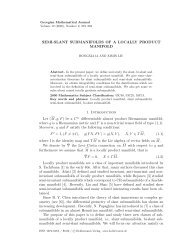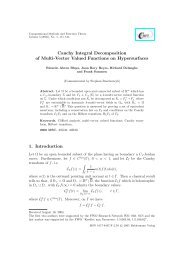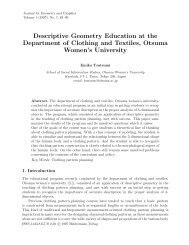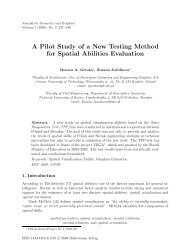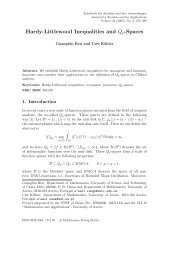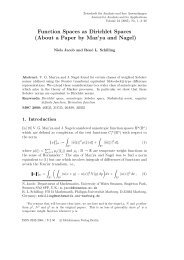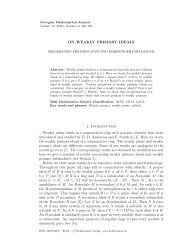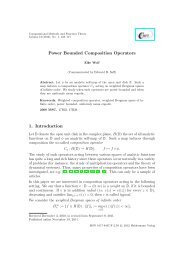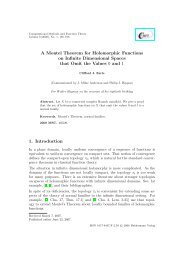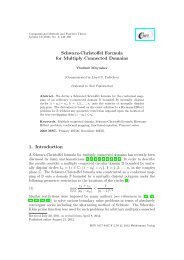On the Solution of the Dirichlet Problem with Rational Holomorphic ...
On the Solution of the Dirichlet Problem with Rational Holomorphic ...
On the Solution of the Dirichlet Problem with Rational Holomorphic ...
You also want an ePaper? Increase the reach of your titles
YUMPU automatically turns print PDFs into web optimized ePapers that Google loves.
5 (2005), No. 2 The <strong>Dirichlet</strong> <strong>Problem</strong> <strong>with</strong> <strong>Rational</strong> <strong>Holomorphic</strong> Data 447<br />
(ii) The solution to <strong>the</strong> <strong>Dirichlet</strong> problem (1) is rational for h(z, ¯z) = R(z),<br />
where R(z) is any rational function <strong>with</strong>out poles on ∂Ω.<br />
(iii) The Riemann map f : Ω → D is rational.<br />
(iv) K(z, a 1 ) and K(z, a 2 ) are rational functions <strong>of</strong> z.<br />
(v) K(z, w) is a rational function <strong>of</strong> z and ¯w.<br />
We mention here a result by S. Bell [5] stating that <strong>the</strong> Bergman kernel on a<br />
multiply connected domain is rational if and only if <strong>the</strong> domain is simply connected<br />
and a Riemann map f : Ω → D is rational. This implies <strong>the</strong> equivalence<br />
(iii) ⇐⇒ (v) above. However, <strong>the</strong> pro<strong>of</strong> we give is independent <strong>of</strong> Bell’s result.<br />
The pro<strong>of</strong> proceeds as follows: We first prove a preliminary lemma, <strong>the</strong>n prove<br />
<strong>the</strong> chain <strong>of</strong> implications (v) ⇒ (iv) ⇒ (iii) ⇒ (ii) ⇒ (i) ⇒ (v). For clarity, we<br />
have written out some <strong>of</strong> <strong>the</strong>se implications as <strong>the</strong>orems.<br />
We conclude this section <strong>with</strong> a few remarks concerning notation. Throughout<br />
<strong>the</strong> pro<strong>of</strong> <strong>of</strong> Theorem 1 we shall use <strong>the</strong> notation<br />
g ∗ (z) := g(z),<br />
and shall use O(Ω) to denote <strong>the</strong> space <strong>of</strong> analytic functions in Ω. (Note that g<br />
is holomorphic in some domain Ω if and only if g ∗ is holomorphic in <strong>the</strong> domain<br />
Ω ∗ := {z : ¯z ∈ Ω}.) We shall use <strong>the</strong> notation P 1 for <strong>the</strong> Riemann sphere (a.k.a.<br />
<strong>the</strong> extended complex plane). We also use <strong>the</strong> notation C(z) for <strong>the</strong> field <strong>of</strong><br />
rational functions in z.<br />
3. Pro<strong>of</strong> <strong>of</strong> Theorem 1<br />
We start by proving <strong>the</strong> following simple lemma.<br />
Lemma 1. Suppose f is an algebraic function whose derivative is rational.<br />
Then f itself is rational.<br />
Pro<strong>of</strong>. Let a 1 , a 2 , . . . , a n be <strong>the</strong> distinct poles <strong>of</strong> f ′ . Expand f ′ in terms <strong>of</strong> its<br />
singular parts:<br />
n∑<br />
f ′ (z) = p(z) + s k (z)<br />
(2)<br />
= p(z) +<br />
= p(z) +<br />
k=1<br />
n∑<br />
p k<br />
∑<br />
k=1 j=1<br />
p n∑ ∑ k<br />
k=1 j=2<br />
c k,j<br />
(z − a k ) j<br />
c k,j<br />
n∑<br />
(z − a k ) + j<br />
k=1<br />
c k,1<br />
z − a k<br />
,<br />
where <strong>the</strong> p k and c k,j are fixed constants, and p(z) is a polynomial.



